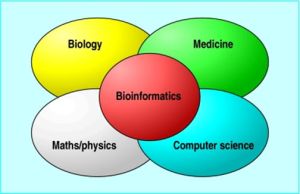Bioinformatics
Bioinformatics emergence of bioinformatics was possible by the merging of two different areas- Biology and Computer science. The scope of bioinformatics involves deposition, storage, and retrieval, of biological data. It is a multidisciplinary field of science, which harnesses biology, medicine, mathematics, chemistry, computer science, information technology, and statistics to facilitate the analysis and interpretation the complex biological data, particularly in the field of genomics. Although, the word ‘bioinformatics’ was first coined in 1968, the first comprehensive definition was published in 1978. Another term ‘Computational Biology’ can also be used to refer Bioinformatics. However, in the case of strict definition, computational biology predominantly involves mathematical modeling and simulations of biological data as well as systems. The main components of bioinformatics include - the development of software and algorithms for the analysis of diverse biological data and the interpretation of complex biological data, by employing different mathematical and statistical algorithms. Mathematical and Statistical algorithms typically are used for processing, analyzing, and visualizing biological data in order to make predictions in a biologically meaningful manner. The bioinformatics toolbox includes but not limited to computer programs such as The Basic Local Alignment Search Tool (BLAST). Bioinformatics database such as Ensemble is a prominent example of biological data storage. Overall, Bioinformatics has now become an essential tool for the management and handling of huge amount of data in modern biology and medicine.

One of the important utility of Bioinformatics is the development of powerful algorithms for measuring DNA sequence similarity. Another application of bioinformatics is to build predictive mathematical models based on the experimental data. One of the most popular use of bioinformatics include the identification of single nucleotide polymorphisms (SNPs) in genes and DNA sequences. Bioinformatics can also be used to predict proteins-protein interactions. In summary, Bioinformatics algorithms have diverse utilities, including identification functional aspects of genes and proteins as well as predicting the three-dimensional shapes of proteins. The classic data of bioinformatics include DNA sequences composed of four nucleotides or whole genomes; amino acid sequences of proteins; and three-dimensional structures of proteins. [Sajib Chakraborty]
